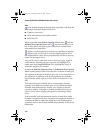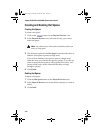
3-13
Adaptec Storage Manager-Browser Edition
4 Now you can accept the default name for the new array or enter
one of your choice. The name you choose must be unique, and
can be up to 15 standard ASCII characters in length.
5 When you click Finish, the system will create the new array.
Advanced Options
Creating an array by clicking Advanced in the Create Array wizard
follows the same basic process as the previous instructions, but at
each step there are additional options for you to use.
Step 1 of 3 in the Advanced area of the Create Array wizard offers
the following additional options:
■ Spanned Volumes and RAID Volumes—As described in
Chapter 1, Introduction, a spanned volume concatenates segments
from two or more drives to form a volume, while a RAID volume
concatenates two or more arrays of the same type.
■ Enable or Disable Write Caching—When write caching is
enabled, the controller stores the data in cache memory on the
controller and will accept another write to this array as soon as
the data from the previous write is safely stored in the
controller’s memory.
Since writing data to memory is much faster than writing it to
the drives, enabling write caching can significantly improve
performance. All data stored in the cache will be written to the
drives when it is most efficient for the controller.
On controllers fitted with a battery, the additional choice
“Enable when protected by battery” is available. Choosing this
option will enable write caching whenever the battery is
operating correctly, and in the event of a power failure the
battery will protect the data currently in cache.
Caution: Default setting for write cache is enabled. This
setting provides the best performance, but in the event of
power failure there is a risk of data loss.
!
UG.book Page 13 Saturday, October 26, 2002 12:08 PM


















